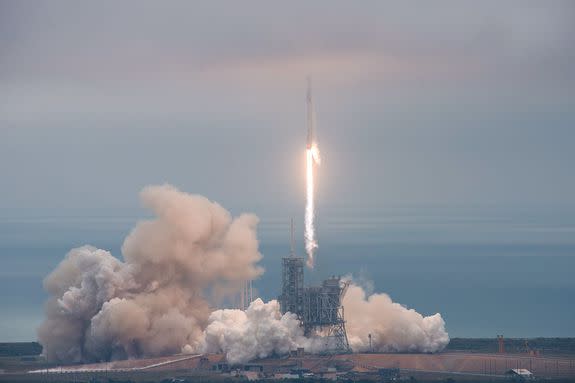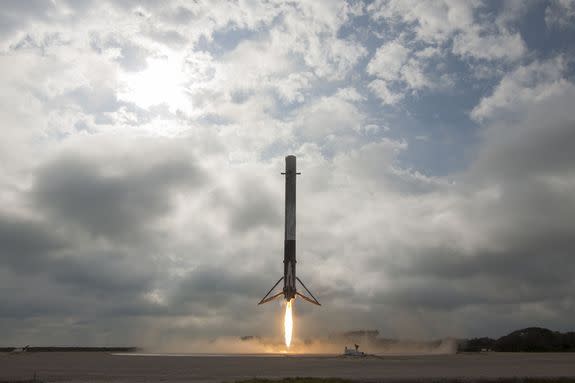Everything you need to know about SpaceX's big moon announcement

Elon Musk is nothing if not ambitious.
The SpaceX founder wants his company to lead the charge to build a city on Mars, and next year, the spaceflight company plans to fly its first astronauts to the International Space Station for NASA.
SEE ALSO: SpaceX wants to send 2 people around the moon in 2018
So generally, SpaceX is pretty busy. But that doesn't mean it can't take on just one other little project, right? Namely, in 2018, SpaceX plans to fly a pair of (presumably rich) private citizens around the moon and bring them back home.
It all sounds pretty intense, so let us break it down for you.
SpaceX is planning to fly around the moon, not land on it
Fly me to the moon ... Okhttps://t.co/6QT8m5SHwn
— Elon Musk (@elonmusk) February 27, 2017
At the moment, SpaceX isn't planning to actually land on the surface of the moon for this mission.
Instead, the company is opting to use its Falcon Heavy rocket and crewed Dragon spacecraft to circumnavigate the moon before coming back home to Earth.
The flight profile involves skimming the surface of the lunar body in a "long loop around the moon," Musk said during a press conference Monday.
The mission should take about a week.
Two people are going, but we don't know who they are
Perhaps the most mysterious part of this whole mission is its passengers.
SpaceX has said that the two space explorers have already paid a pretty hefty deposit for the chance to fly on this mission, though the company hasn't yet revealed the names of the individuals expecting to fly next year.
The mission itself will cost tens or hundreds of thousands of dollars for the hopeful space explorers, and Musk is keeping their names confidential since they haven't given the company permission to release their names.
All we know for now is that they know each other and it's not Richard Garriott, a space tourist who visited the International Space Station.
Not me... yet! https://t.co/GtVBfw7s2o
— Richard Garriott (@RichardGarriott) February 27, 2017
Musk also said that "it's nobody from Hollywood" when asked if the passengers are celebrities.
They will be trained before flight
No matter who they are, the two would-be space explorers will be trained before they fly to the moon.
"We expect to conduct health and fitness tests, as well as begin initial training later this year," SpaceX said in a statement.
"Other flight teams have also expressed strong interest and we expect more to follow. Additional information will be released about the flight teams, contingent upon their approval and confirmation of the health and fitness test results."
The mission will launch from a historic pad
SpaceX is planning to launch the Falcon Heavy to the moon from Kennedy Space Center's Launch Complex 39A in Cape Canaveral, Florida.

Image: spacex/flickr
This pad marked the starting point for many of NASA's Apollo missions to the moon, and SpaceX has a 20-year lease out on it now.
The space company recently launched its first mission from the pad, and it plans to use it for many more in the future.
This will be the farthest any human has been from Earth in more than 45 years
The Apollo 17 moon landing in 1972 marks the last time humans flew to deep space.
Since then, NASA has focused on low-Earth orbit with the building of the International Space Station, ending the space agency's lunar ambitions.
If SpaceX succeeds in launching the customers to beyond the moon for their flyaround trip, it will be the farthest afield any human has flown since Apollo 17.
SpaceX has never been shy about its desire to bring humans back to deep space.
The company's goal since it was founded in 2002 has been to make humans a multi-planet species by launching crewed missions to Mars, a plan they hope to enact in the coming decades as they drive down the cost of spaceflight by reusing rockets for more than one launch.
This shouldn't be the only moon mission for SpaceX
If that schedule remains in place, Musk is thinking that the company can fly at least one or two moon missions per year when they really get going.

Image: spacex/flickr
The SpaceX founder thinks these types of missions could be a good source of revenue for the company if multiple teams are interested in taking the trip.
These types of missions could also be of interest to NASA.
Instead of flying straight to Mars, as was the plan under the Obama administration, it's possible that President Donald Trump's NASA will want to head back to the moon before moving on to the red planet.
Don't be surprised if SpaceX doesn't launch on time
Musk's company is somewhat infamous in the space industry for its inability to keep to a schedule, and this moonshot might not be any different.
SpaceX has yet to launch a test flight of its Falcon Heavy rocket, though that is set to happen later this year, and the company hasn't yet flown people within its crewed Dragon capsule.
Both the rocket and capsule will need to fly multiple times before launching any kind of mission to the vicinity of the moon.
At the moment, SpaceX is planning to launch an uncrewed flight of its Dragon to the Space Station at the end of this year, with a crewed mission following shortly after.
We'll just have to wait and see if that schedule holds.
